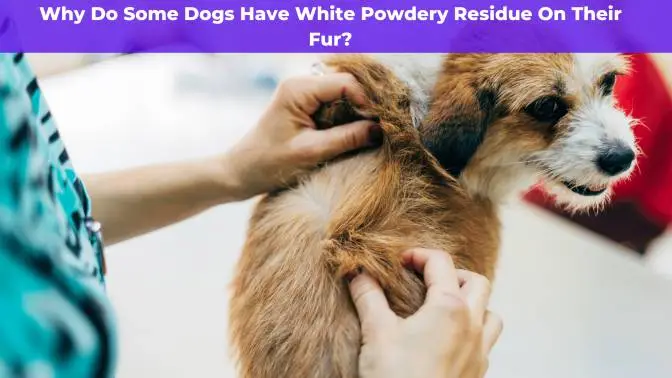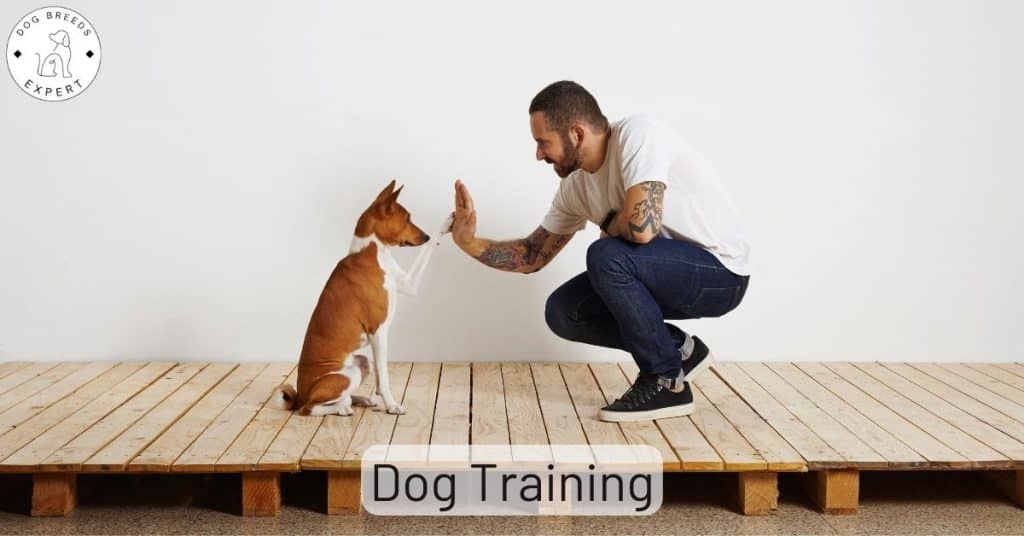Yesterday, when I was petting my dog Shadow, I noticed some white powder residues on their skin. I immediately searched for the cause of this white powder and how it could have affected my furry friend’s skin.
It turns out that Shadow had dandruff, a common condition that affects dogs just like it affects humans. Dandruff appears as small, white flakes that can fall off the skin. It can be caused by a variety of factors, including diet, fungal infections, allergies, and bacterial infections. Fortunately, this condition can be cured by grooming and giving supplements.
In this article, we’ll discuss everything you need to know about dandruff in dogs. From the causes to the symptoms and treatments, we’ll cover it all. By following the right approach and taking the necessary precautions, you can ensure that your furry friend has a healthy and happy life free from dandruff. So, let’s dive into the world of dandruff in dogs and learn how to prevent and treat this condition.
What is the white powdery residue on your dog’s fur?
Do dogs get dandruff? Yes, they can. Not only do human dogs get dandruff too. Dogs’ dandruff is usually a result of dry skin, the condition known medically as Seborrhea.
It irritates dogs’ skin and causes them to scratch intensely. The dead skin then falls off. Then white flakes can be seen on the surface of the skin. So dandruff is an uncomfortable experience for your doggy.
In humans, dandruff affects the scalp. Symptoms include flaking and mild itchiness in the skin of the scalp. Because of this condition can sometimes result in mental or self-esteem problems.
A more severe form of the condition, which includes inflammation of the skin, the condition known as Seborrhoeic dermatitis. The condition is somewhat different for dogs.
Unlike humans, dogs can develop dandruff, although rather than on their scalp, a dog’s dandruff tends to show up on the dog’s face, skin, and flanks.
What is the white powdery residue on your dog’s fur?
Do dogs get dandruff? Yes, they can. Not only do human dogs get dandruff too. Dogs’ dandruff is usually a result of dry skin, the condition known medically as Seborrhea.
It irritates dogs’ skin and causes them to scratch intensely. The dead skin then falls off. Then white flakes can be seen on the surface of the skin. So dandruff is an uncomfortable experience for your doggy.
In humans, dandruff affects the scalp. Symptoms include flaking and mild itchiness in the skin of the scalp. Because of this condition can sometimes result in mental and self-esteem problems.
A more severe form of the condition, which includes inflammation of the skin, the condition known as seborrhoeic dermatitis. The condition is somewhat different for dogs.
Unlike humans, dogs can develop dandruff, although rather than on their scalp, dogs’ dandruff tends to show up on a dog’s face, skin, and flanks.
What is causing my dog’s skin to flake?
It is usual for your doggy to shed dead skin cells, and dogs usually groom these dead cells before you notice them.
But sometimes, something causes the skin to shed more than normal, resulting in dry, flaky, red patches on your dog’s coat. So the main symptoms of dandruff are an itchy scalp and flakiness, red and greasy patches of skin.
Another reason is that your dog might have flaky skin if she’s constantly licking, scratching, or biting her skin. This condition may worsen in the winter.
Genetic and environmental factors can also affect flaky skin, dandruff, and dogs’ excessive growth of skin cells.
1. Environmental factors
As I have mentioned earlier, flaky skin in dogs can be caused by a wide variety of reasons. Luckily, most of these concerns can be successfully treated only after a correct diagnosis.
Skin cells that grow and shed off too fast are the major problem. It is not clear why that happens exactly. The major fungus Malassezia creates dandruff.
This fungus forms on the scalp of most healthy adults (humans) and in the skin (dogs) without causing any problems. Dandruff scalps/skin consistently show a marked increase in the abundance of Malassezia fungi. Cold, dry winters can trigger dandruff in your doggy and make it worse.
2. Other factors.
Dandruff may get worse when the dog is stressed or sick. One common cause is seborrheic dermatitis or Seborrhea.
What Causes Dandruff in Dogs.
The major causes of dandruff in dogs include allergic reactions, bacterial infections, yeast/ fungi infections, and parasitic infections. Infections and some endocrine diseases also cause dandruff conditions in dogs, such as Cushing syndrome or hypothyroidism.
As owners, actually, we don’t think much about the skin hidden underneath the coats. We just focus on the growth of their fur and coat. Dandruff is the first visible sign that your doggy has a skin disease.
For dogs with dark coats, dandruff is easy to identify. The dead skin looks like white flakes, often making their coat appear dusty or dull.
Dandruff is often more difficult to detect in light-colored dogs, but certain behaviors can point to its presence. Excessive scratching or licking indicates that your dog is not comfortable. You will be able to find traces of dandruff dust on carpets or furniture.
Dandruff is bothersome, but it’s not harmful by itself. More concerning is that it’s a symptom of dry or irritated skin.
You can see below that some factors cause dandruff in dogs…
- Grooming activities – Bathing your doggy too often or with harsh soaps
Every dog requires bathing sometimes, but probably not as often as you think. Many dog breeds can lose valuable oils in their skin due to too much bathing, so this can be caused for getting dandruff on doggy skin. So be sure to bathe your dog for an appropriate time schedule.
- Unhealthy food habits
- Fungal infections like ringworm conditions and yeast dermatitis skin conditions. (Also, ringworm can make your dog’s belly looks dirty. So, be aware of that.)
- Extreme temperatures and dry air
- Allergies
- Seborrheic dermatitis
- Bacterial infections such as pyoderma
- Parasites like fleas and mites
Now you can see there is such a wide range of potential reasons for your dog’s dandruff.
What to do if a dog has dog Dandruff?
Here are some of the home remedies you can do
- “GROOMING, “
You know this is a must. This is the most simple and easy way to maintain your dog’s coat and keep it free of dandruff.
- Give supplements of omega-3 fatty acids.
- Feed your dog a good diet.
- Antifungals treatment
Visit your veterinary surgeon to learn about the best antifungal treatment that suits your dog.
Here are some of the antifungals shampoo on the market
- Bexley Labs Curaseb Chlorhexidine Shampoo
- Dechra MiconaHex + Triz Pet Shampoo
- Pet MD Medicated Shampoo
Antifungal shampoos use special ingredients to control dandruff in dogs’ coats and skin.
Dog anti-dandruff shampoos come in various chemicals to treat dandruff and its reasons. Ingredients in some anti-dandruff shampoos are medicated to treat the skin and kill the organisms that cause infections.
The owner must consult a vet for a diagnosis before using the shampoo, or the wrong products can make things terrible.
What are the good practices to keep your dog from getting dog Dandruff in the future?
You can prevent dandruff in your doggy coat or remove this type of dandruff with simple changes in the dog’s grooming routine.
Lets’ take them one by one.
First one- Brushing: This step may prevent dandruff in the first place. Brush your dog regularly with an appropriate brush to keep the skin and coat healthy.
Shampooing: Select a proper antidandruff shampoo for bath him & reduce the use of soap to bathe your dog.
Oatmeal baths: Did you confused? Yeah, oatmeal baths are a well-known good dandruff treatment and are easy to do at home. Firstly, wet your dog with warm water and slowly add the oatmeal mixture to the skin. After that, keep the mixture on your doggy’s skin for several minutes before rinsing it.
Humidifiers: You can use a humidifier at your house. It also prevents getting dandruff on their coat.
Prevent too much bathing: Many dogs lose some valuable oils in their skin due to over-bathing. So this is a reason for dandruff. As a good owner sure to ask your vet what an appropriate bathtime schedule suits your dog
Keep the doggy’s coat very clean: Clean the coat well after a bath by using a dry towel
Nutrition: An unbalanced diet can decrease essential nutrients needed for a healthy coat, which will cause dandruff condition. To prevent this, you can give supplements of omega-3 fatty acids. Give your dog a good diet full of nutrition.
Things to be aware of.
Dandruff in itself is not more harmful. Actually, it gives an unsightly appearance. Dandruff is like a secondary issue. It may be another clinical sign of a disease.
So it is essential to get to the reason for this problem and treat precisely the underlying cause, not just for dandruff.
Conclusion.
As we all know, dandruff, those small white flakes of dead skin, are not a major health issue or disease condition. But it gives a little uncomfortable feeling.
As I early said, this dandruff affects dogs too. As dog owners, your responsibility is to treat your pet’s skin and coat well to restore its normal luster. I think this article will help you to solve this problem.



